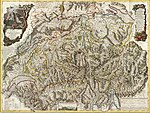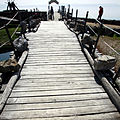Early history of Switzerland
| History of Switzerland |
|---|
 |
| Early history |
|
| Old Swiss Confederacy |
|
| Transitional period |
|
| Modern history |
|
| Timeline |
| Topical |
|
|
|
The early history of Switzerland begins with the earliest settlements up to the beginning of
Prehistory
Paleolithic to Mesolithic
A hand-axe fashioned by Homo erectus has been found in Pratteln, which has been dated to 300,000 years ago.[1] Neanderthal presence is known from the Grotte de Cotencher in Neuchâtel, dating to 70,000 years ago[2] and from the caves of Wildkirchli in the Appenzell Alps, dated to about 40,000 years ago.[3]
-
Venus of Monruz, c. 9000 BC
Neolithic to Copper Age
The Neolithic reached the Swiss plateau before 7,000 years ago (late 6th millennium BC), dominated by the Linear Pottery culture. The area was relatively densely populated, as is attested to by the many archeological findings from that period. Remains of
-
Pfyn culture settlement at Breitenloo, c. 3700 BC
-
Neolithic implements, pottery and foodstuffs, Cortaillod culture
-
Crystal arrowhead, Cortaillod culture, c. 3500 BC
-
Wooden wheel fragment, Horgen culture
-
Megalithic dolmen, Horgen culture
-
Alpine copper axe, 4th millennium BC
-
Copper necklace and ornaments, c. 2700 BC
Bronze Age
In the 3rd millennium BC, Switzerland lay on the south-western outskirts of the
The Bronze Hand of Prêles dating from the 16th-15th century BC, is a unique find from the Tumulus culture period.[6] Described as "the earliest metal representation of a human body part ever found in Europe",[7] it may have been a ritual object, or mounted on a standard like similar metal hands known from the Iron Age,[8] or possibly a prosthesis.[9] It was found in a grave along with a bronze hair-ring, pin and dagger. The hand had a golden bracelet or cuff decorated with solar motifs.[10]
-
Dagger,Unetice/Rhôneculture c. 2000 BC
-
Thun-Renzenbühl axe, c. 1800 BC
-
Bronze swords, Urnfield culture, 10th century BC
-
River and lake finds from Bern, Urnfield culture
-
Lake settlement at Cortaillod-Est
Iron Age


The Swiss plateau lay in the western part of the Early Iron Age Hallstatt culture,[11] and it participated in the early La Tène culture (named for the type site at Lake Neuchâtel) which arose out of the Hallstatt background from the 5th century BC.[12]
By the final centuries BC, the Swiss plateau and Ticino were settled by
The distribution of La Tène culture burials in Switzerland indicates that the Swiss plateau between Lausanne and Winterthur was relatively densely populated. Settlement centres existed in the Aare valley between Thun and Bern, and between Lake Zurich and the Reuss. The Valais and the regions around Bellinzona and Lugano also seem to have been well-populated; however, those lay outside the Helvetian borders.
Almost all the Celtic oppida were built in the vicinity of the larger rivers of the Swiss plateau. About a dozen oppida are known in Switzerland (some twenty including uncertain candidate sites), not all of which were occupied during the same time. For most of them, no contemporary name has survived; in cases where a pre-Roman name has been recorded, it is given in brackets.[13] The largest were the one in
A female who died in about 200 B.C found buried in a carved tree trunk during a construction project at the Kern school complex in March 2017 in Aussersihl. Archaeologists revealed that she was approximately 40 years old when she died and likely carried out little physical labor when she was alive. A sheepskin coat, a belt chain, a fancy wool dress, a scarf and a pendant made of glass and amber beads were also discovered with the woman.[15][16][17]
-
Grächwil hydria (Greek import), Hallstatt culture, 570 BC
-
Gold jewellery, Hallstatt culture, c. 550 BC
-
Jewellery, La Tène culture
-
Jewellery, La Tène culture
-
Mont Vully oppidum, La Tène culture
-
Carnyx ornament, La Tène culture, c. 200 BC
-
Lake depositions at La Tène
-
Reconstructed Celtic Bridge at La Tène, 3rd century BC
Roman era

In 58 BCE, the
The following 300 years saw extensive Roman settlement, including the construction of a road network and the founding of many settlements and cities. The center of Roman occupation was at Aventicum (
The Romans also developed the
In 259,
-
Roman remains at Nyon
-
Roman theatre of Augusta Raurica
-
Silver plate from Augusta Rarica
-
Amphitheatre at Avenches
Christianization and post-Roman era
In the late Roman period in the 3rd and 4th centuries, the
The first bishoprics were founded in the 4th and 5th centuries in
With the fall of the
The Burgundy kings furthered the Christianization through newly founded monasteries, e.g. at
Switzerland in the Middle Ages
Early Middle Ages
Under the
Louis the German in 853 granted his lands in the
When the land was granted to the monastery, it was exempt from all feudal lords except the king and later the
In the 10th century, the rule of the Carolingians waned:
High Middle Ages
King
The dukes of
The rise of the Habsburg dynasty gained momentum when their main local competitor, the
Under the
While some of the "Forest Communities" (Waldstätten, i.e. Uri, Schwyz, and Unterwalden) were reichsfrei the Habsburgs still claimed authority over some villages and much of the surrounding land. While Schwyz was reichsfrei in 1240, the castle of
He instituted a strict rule in his homelands and raised the taxes tremendously to finance wars and further territorial acquisitions. As king, he finally had also become the direct
In the Valais, increasing tensions between the
The 14th century

With the opening of the
The 14th century in the territory of modern Switzerland was a time of transition from the old feudal order administrated by regional families of lower nobility (such as the houses of
As elsewhere in Europe, Switzerland suffered a crisis in the middle of the century, triggered by the
The balance of power remained precarious during the 1350s to 1380s, with Habsburg trying to regain lost influence; Albrecht II besieged Zürich unsuccessfully, but imposed an unfavourable peace on the city in the treaty of Regensburg. In 1375, Habsburg tried to regain control over the Aargau with the help of Gugler mercenaries. After a number of minor clashes (Sörenberg, Näfels), it was with the decisive Swiss victory at the battle of Sempach 1386 that this situation was resolved. Habsburg moved its focus eastward and while it continued to grow in influence (ultimately rising to the most powerful dynasty of early modern Europe), it lost all possessions in its ancestral territory with the Swiss annexation of the Aargau in 1416, from which time the Swiss Confederacy stood for the first time as a political entity controlling a contiguous territory.
Meanwhile, in Basel, the citizenry was also divided into a pro-Habsburg and an anti-Habsburg faction, known as Sterner and Psitticher, respectively. The citizens of greater Basel bought most of the privileges from the bishop in 1392, and from this time on, though Basel nominally remained the domain of the prince-bishops until the Reformation, it was de facto governed by its city council, which since 1382 had been dominated by the city's guilds. Similarly, the bishop of Geneva granted the citizenry substantial political rights in 1387.
Other parts of western Switzerland remained under the control of Burgundy and Savoy throughout the 14th century; the
See also
References
- ^ Archäologie Baselland
- ^ Swiss Info - Meet a Neanderthal Woman from one of Europe's Oldest Cave Sites
- ^ Wildkirchli in German, French and Italian in the online Historical Dictionary of Switzerland.
- ^ Before between 1,300 and 1,200 generations ago according to a simulation in Currat, M.; Excoffier, L. (2004). "Modern Humans Did Not Admix with Neanderthals during Their Range Expansion into Europe". PLOS Biol. 2 (12): e421. )
- (21 August 2008), the date is revised to c.4500BC instead of c.3000BC (in German)
- ^ "Photo of the Bronze Hand of Prêles".
- ^ "3,500-Year-Old Hand is Europe's Earliest Metal Body Part". National Geographic. 2018. Archived from the original on February 19, 2021.
- ^ "Das bronzezeitliche Grab und die Bronzehand von Prêles. Ergebnisse der Table Ronde vom 30.Oktober 2019 in Bern".
- ^ "Was This Man a Bronze-Age Cyborg? His Metal Hand May Have Been a Prosthetic". Live Science. 2018.
- ISBN 978-07141-2349-3.
- ^ N. Müller-Scheeßel, Die Hallstattkultur und ihre räumliche Differenzierung. Der West- und Osthallstattkreis aus forschungsgeschichtlicher Sicht (2000)
- ^ La Tène site description Archived 2009-02-07 at the Wayback Machine(in French)
- ^ Andres Furger-Gunti: Die Helvetier: Kulturgeschichte eines Keltenvolkes. Neue Zürcher Zeitung, Zürich 1984, pp. 50–58.
- ^ Bern, Engehalbinsel, Römerbad Archived 2007-09-30 at the Wayback Machine
- ^ July 2019, Laura Geggel-Associate Editor 30 (30 July 2019). "Iron Age Celtic Woman Wearing Fancy Clothes Buried in This 'Tree Coffin' in Switzerland". livescience.com. Retrieved 2020-04-05.
{{cite web}}:|first=has generic name (help)CS1 maint: numeric names: authors list (link) - ^ Solly, Meilan. "This Iron Age Celtic Woman Was Buried in a Hollowed-Out Tree Trunk". Smithsonian Magazine. Retrieved 2020-04-05.
- ^ "Kelte trifft Keltin: Ergebnisse zu einem aussergewöhnlichen Grabfund - Stadt Zürich". www.stadt-zuerich.ch (in German). Retrieved 2020-04-05.
- ^ a b c d e Encyclopædia Britannica Online: Roman Switzerland accessed November 13, 2008
- ^ a b c d e f g Chisholm, Hugh, ed. (1911). . Encyclopædia Britannica. Vol. 26 (11th ed.). Cambridge University Press.
Bibliography
- Im Hof, U.: Geschichte der Schweiz, ISBN 3-17-017051-1
- Schwabe & Co.: Geschichte der Schweiz und der Schweizer, ISBN 3-7965-2067-7































